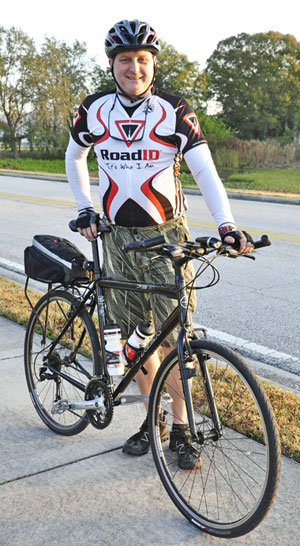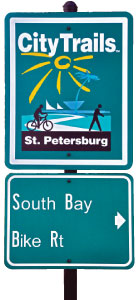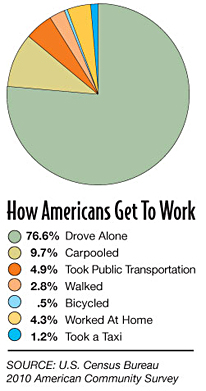By Nanette O’Hara

In September 2010, Larry Meadows made a commitment to get in shape. With little time to exercise, the 43-year-old St. Petersburg resident took a friend’s advice and decided to try riding a bike to his job with Raymond James Financial in the Feather Sound area of central Pinellas.
By September 2011, Meadows had logged 3,100 miles on his commutes, lowered his resting heart rate from 77 to 43 beats per minute, and lost an impressive 45 pounds. He also calculated savings of $721 in gas costs, based on spending an average of $3.50 per gallon on gas to drive his truck 22 miles a day instead of pedaling his Trek.
And he’s still at it, faithfully traveling to work each day by pedal power, in every kind of weather but thunderstorms.
“My workday begins with 45 minutes of exercise and head-clearing, and ends with 45 minutes of exercise and head-clearing,” Meadows said.
Though still the exception in the car-choked Tampa Bay region, Meadows is less an outlier than you might think. According to the Census Bureau’s American Community Survey, the Tampa Bay area has double the national average of bike commuters, and the number of people riding their bike to work increased by 31% from 2000-2008. We also are among the most dangerous areas for cyclists in the nation. From 2005-2009, 105 cyclists were killed on roads in Hillsborough, Manatee, Pasco and Pinellas counties, nearly one-fifth of the total cycling fatalities in the state, according to statistics from the Florida Department of Highway Safety and Motor Vehicles.
Despite the hazards, bicycle commuting is clearly growing in popularity, in Tampa Bay and across the U.S.
“It’s beginning to reach a tipping point, where people may not bike themselves, but they know other people who do,” said Brian Smith, the recently retired planning director for Pinellas County who pedaled from his home in Ozona to his office in Clearwater for 15 years.
Cycling to work has a big upside. It’s great exercise, it reduces stress, and it saves both fuel costs and wear and tear on automobiles. Since most Americans live within five miles of their workplace, the average commute is pretty short. In urban areas like ours, it typically only takes one-third longer to bike than to drive to work – in many cases, it’s faster than sitting in traffic on congested roads.
There are societal as well as individual rewards. According to the U.S. Environmental Protection Agency, transportation is the largest single source of air pollution in the nation, and driving a car is probably a typical citizen’s “most polluting daily activity.” In Tampa Bay, studies have shown that air pollution is responsible for as much as 40% of the harmful nitrogen going into the bay. Vehicle emissions, in the form of nitrogen oxides (NOx) account for about one-quarter of that.
Remember the adage, “What goes up must come down?” That applies to automobile tailpipes as well. The NOx that comes out of them, because it is discharged low to the ground, tends to stay close to home, where it falls directly on Tampa Bay or is washed into the bay with rainfall.
“I think most people aren’t aware of the impact that air pollution has on water quality in the bay,” said Holly Greening, executive director of the Tampa Bay Estuary Program. “And what we’ve found in Tampa Bay is not unusual for urban areas across the country.”
Although cars are becoming more fuel-efficient and less polluting, increases in the sheer numbers of cars from population growth could negate the gains achieved by cleaner emissions, she noted.
Public or alternative modes of transit offer long-term solutions, and that includes cycling. However, for a region as dependent on automobiles as Tampa Bay, making room for bicyclists isn’t easy, or cheap. The transportation system in congested urban areas like Tampa was originally designed to move people – make that, people in cars – from one point to another as fast as possible.
But with the recognition that varied modes of transportation – light rail, buses, bicycles, water taxis, even feet – make for more desirable communities, planners throughout the region are plotting a network of bike lanes to accommodate both recreational and commuter cyclists.
“Roads get you from one community to another, but they don’t connect a community the way that bike and pedestrian paths do,” Smith said.
The Pinellas Trail is one of those bike paths doing double or even triple duty. A decade after construction began on what is now a 37-mile-long cycling and pedestrian path through Pinellas County’s midriff, a survey conducted by county planners revealed a surprise: about two-thirds of the bicyclists using the trail were using it to go somewhere for a purpose, such as school, work or shopping. Planners had assumed its main use would be recreational.
Because it is off-limits to cars, it is an ideal way to get around safely. Overpasses across the busiest highways, such as US 19, allow cyclists to rise above the chaos below. At Ozona Elementary School in far North Pinellas, a substantial percentage of the students ride their bikes to school using the trail.
County bicycle/pedestrian planner Sue Miller says that is the true immeasurable value of the trail. “It really addresses people’s needs whatever they are,” she said, from people going to work or to the grocery store to pick up a few items, to children biking to school, to serious recreational cyclists with tiny computers attached to their handlebars to record their time, distance and speed.
Pinellas park ranger Pat McGory takes the trail to work every day from his home in St. Pete to Boca Ciega Millennium Park in Seminole. Like Meadows, he began biking to work for health reasons. At 51, he’s shed 35 pounds in two years and lowered his blood pressure. He also saves at least $10 a week in gas and reduced his driving so much he even sold the family’s second car.
“I started doing it for health reasons and I liked it so much I stayed with it,” he said. “Being able to use the trail gives me a much safer way to travel than surface roads. I see some of the same people riding at the same time every day, and I assume they’re commuting too.”
Unfortunately, there is only one Pinellas Trail. The region’s other major dedicated cycling/pedestrian pathway – the Friendship Trail and Bridge over Tampa Bay – has been closed for several years and is slated to be demolished because of structural issues.
But communities are slowly building a tapestry of bicycle lanes and designated “Share The Road” strips along existing roadways for cyclists. Tampa currently has 60 miles of designated bike lanes; St. Petersburg more than 20 miles; and tiny Palm Harbor nearly 14 miles (thanks largely to the Pinellas Trail).
St. Pete resident Meadows, who cycles with his son for recreation on the weekends as well as to work during the week, has chronicled the good, bad and ugly of his commuting odyssey through his blog, Trek2Work.com – including one day when he had to intentionally ditch his bike to avoid being hit by a motorist turning directly in front of him, one hand on his coffee cup, the other on his cell phone and his knees on the steering wheel.
Pinellas County and Tampa Bay have a long way to go before they are as bike-friendly as Seattle or Minneapolis-St. Paul, but it is getting better, he said. “The more motorists see people on bikes, the more they get used to us and learn to live with us.”
Chip Haynes, a Clearwater resident and year-round commuter, has been bicycling since he was seven years old and “just never outgrew it like most people do.”
Haynes, a member of Pinellas County’s Bicycle Advisory Committee, is an authority on what he calls “utility cycling.” He authored a book, “The Practical Cyclist” that provides a wealth of information about using bicycles as a major form of transportation. He rides his bike to stores, to appointments, everywhere he reasonably can. With about 30 bikes in his garage – all with their own unique story – he’s got one for just about any occasion.
Haynes says there are all sorts of perfectly good reasons to give bike commuting a try – health, fitness, saving energy, saving money – but “the main reason is that it’s fun.
“Riding a bike makes you feel like a kid again, pure and simple,” he said.

Best Bike Rides in Tampa Bay
Whether you’re riding for fun, fitness or utility, here are some of our favorite rides:
1—The Pinellas Trail (throughout Pinellas County)
One of the longest urban bike trails in the nation, the Pinellas Trail runs 37 miles north and south along an old railroad line. The Trail is still being expanded; additions will eventually create a complete loop of the county. The most scenic section is from Dunedin to Tarpon Springs.
www.pinellascounty.org/trailgd
2—Jay B. Starkey Wilderness Park (southern Pasco County)
The 7.5 mile paved trail (13 miles round trip) through the Starkey wellfield showcases gorgeous pine flatwoods and hardwood hammocks that harbor deer, fox squirrels, gopher tortoises, bluebirds and other wildlife. The Starkey Trail connects with the Suncoast Bicycle Trail on one end and Starkey Boulevard on the other, for those who want a longer ride.
www.swfwmd.state.fl.us/recreation/areas/starkey-park.html
3—The Suncoast Parkway Bicycle Trail (Tampa, New Port Richey, Spring Hill, Brooksville)
Running parallel to the Suncoast Parkway for 41.3 miles from Tampa to the Chassahowitzka area, the Suncoast is a part of the state’s Greenways and Trails system. Portions closer to Tampa (such as the SR 54 access) get fairly crowded on weekends; segments north of SR 50 are rarely busy, exceptionally scenic and feature something
rare for Florida: hills!
www.dep.state.fl.us/gwt/guide/regions/westcentral/trails/suncoast.htm
4—Flatwoods Park (Thonotosassa area of eastern Hillsborough County)
Home to the Morris Bridge wellfield, Flatwoods is part of the Southwest Florida Water Management District’s Lower Hillsborough Wilderness Preserve. Its 7-mile paved multi-use trail is extremely popular with both casual and avid recreational cyclists. The trail winds through beautiful pine flatwoods with abundant wildlife, and connects with New Tampa subdivisions via surface roads.
www.swfwmd.state.fl.us/recreation/areas/lh-flatwoods.html
5—City of St. Petersburg Bike Trails (throughout St. Petersburg)
Officially designated a Bronze level Bicycle-Friendly Community by the League of American Bicyclists, St. Pete is working hard on bicycle and pedestrian enhancements. The “City Trails” program has designated bike lanes, “share lanes,” sidewalks, and paths that link the city’s charming downtown with points north and south.
www.stpete.org/transportation/citytrails/index.asp
6—Upper Tampa Bay Trail (Northwest Hillsborough)
This 7.5-mile trail runs from the Memorial Highway area of Tampa north past Gunn Highway, mainly through residential areas with overpasses, underpasses and bridges. Planned expansions will add another 7 to 8 miles and eventually connect it with the Suncoast Parkway Trail.
www.dep.state.fl.us/gwt/guide/regions/westcentral/trails/pdfs/UTB_Trail_PDF.pdf
7—Bayshore Boulevard in Tampa
The city’s iconic sidewalk along Hillsborough Bay is a victim of its own popularity, so crowded much of the time that bicycling is not always safe, or easy. Help is on the way as the city nears the end of a major project to add dedicated bike lanes to the surface road in both directions, along with other enhancements to slow traffic and make crossing safer for all users.
www.tampagov.net/dept_transportation/information_resources/Bayshore_blvd_enhancement_project.asp

Ready To Roll? Tips for Getting Started
- Obey all traffic laws. Bicycles are considered vehicles, subject to the same rules of the road as cars. Don’t run red lights or stop signs. Do ride on the right-hand side of the road.
- Wear a helmet and bright clothing. You want to be seen, and you want to protect the one irreplaceable body part: your brain.
- Never wear headphones or ear buds while cycling. It’s not only against the law, it’s just plain stupid.
- Keep your bike tires properly inflated. This is all about comfort and efficiency. You’ll be amazed at the difference.
- Lock your bike up, all the time and everywhere. A good lock is cheaper than a taxi ride, and a new bike.
SOURCE: Chip Haynes, author of “The Practical Cyclist”
Bike Buddies
Want a pedal pal to share the ride to work? TBARTA, the regional transportation agency, will put you in touch with another cyclist going your way through the Bike Buddy program. Learn more and sign up atwww.tampabayrideshare.org.
No need to fret about those times when you really need to get somewhere in a hurry. Participants who ride their bikes to work at least two days a week are eligible for free taxicab rides home in emergencies.
Currently, 114 commuter cyclists are registered for the baywide program, with 63 biking to work. The rest are looking for matches.
[su_divider]Originally published Winter 2012